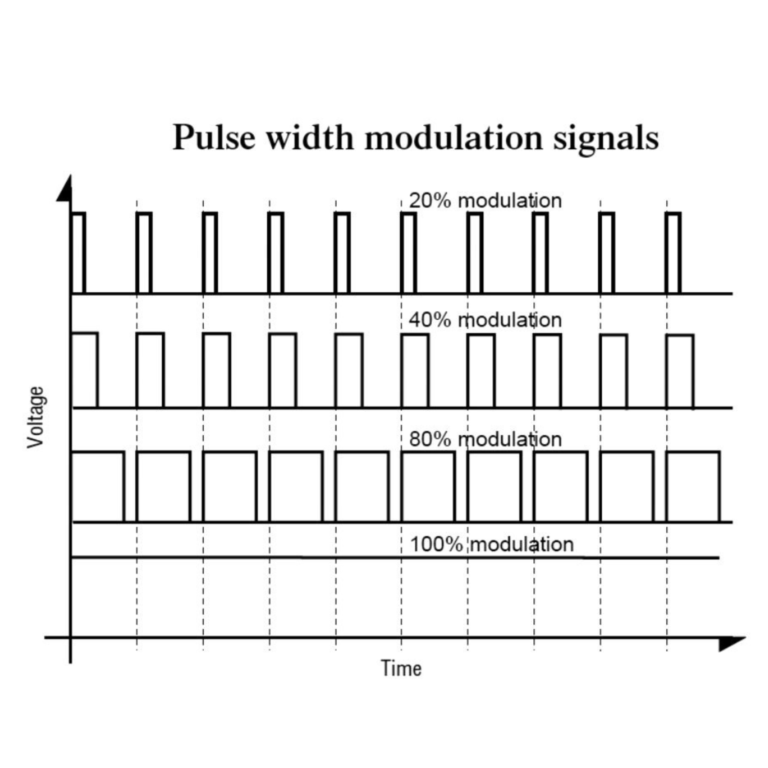REVERSIBLE FLOW FANS
Users have pursued new and innovative ways to control DC fans to provide customized thermal management solutions. Over the years, innovations like brushless DC motors and PWM speed control technologies have advanced the thermal management industry. With new micro-controller-based designs, a new feature has now become possible, directional airflow and speed control. Previously, if the designer wanted to achieve two different directions of airflow, two fans would be required. This arrangement added cost to the bill of materials (BOM), required more room in the design to accommodate both fans, increased maintenance requirements, and lowered product reliability as two fans could be a point of failure. A single fan with directional and speed control capability had been highly desirable to overcome these flaws of the two-fan design. In recent years reversible flow fans have been engineered to meet these needs.
How reversible fans are controlled
PWM speed control is a method where a fixed frequency AC square wave signal is provided to the fan and the Duty Cycle of the waveform is altered to match the desired speed, as shown below.
The frequency is typically fixed at 25Khz, but most manufacturers accept a range of frequencies as specified on their data sheets. By varying the duration of time the waveform is positive voltage (HIGH) versus zero volts (LOW), the speed of the fan is controlled varying from 0% to 100%. This 0% duty cycle to 100% duty cycle can be matched to the fan speed curve in any fashion desired. But typically a customer will want a 0% duty cycle to represent a completely stopped or minimal RPM fan, with 100% representing full speed operation. It is important to note that 0% duty cycle is the same as grounding the PWM control wire (0 V), and 100% duty cycle is the same as holding the line at a positive voltage HIGH state. Many manufacturers also design fans so that a disconnected “Floating” PWM input line will run the fan at 100% RPM, similar to a non-PWM controlled fan, allowing for flexibility in different applications.
Reversible fans extend this control paradigm by segmenting the PWM duty cycle curve into “Forward” versus “Reverse” regions, as shown in the graphic below.


This segmentation still allows for speed control over a condensed duty cycle range, while creating a system whereby the direction of flow can be controlled without requiring additional control wires or circuitry. In most cases a simple firmware or software change in the customer’s equipment can create the capability of controlling the direction, with minimal disruption of industry standard control assumptions. A generous “stop” region is provided in the duty cycle curve to ensure the fan is at 0 RPM when required.
Reversible Flow Applications
Reversible flow fans are a specialty design that enables some unique use cases. It should be noted however that the performance of these fans is asymmetrical. The forward flow performance will always differ from the reverse flow performance due to differences in how the blades are optimized and the aerodynamics of the venturi as it affects air flow. This means that the forward airflow CFM and static pressure will differ from the reverse flow specifications. The amount of variation differs depending on the frame size and design, but these differences should be listed in the product data sheet. Despite this limitation, there are some cases where Reversible Flow is the perfect solution to unique problems. Some examples of these are:
- Fans used in outdoor applications where the device normally intakes air in one direction, but a periodic reverse flow helps to ensure that air pathways do not become clogged with bugs or other environmental debris. This can reduce costly maintenance visits to remote locations.
- Fans used in equipment where seasonal environmental changes create the need for different airflow of intaking versus exhausting air.
- Situations where a “confidence check” is needed to confirm the proper operation of air flow monitoring sensors.
- Applications where dynamic control of air flow pathways is needed, and large air flow check valves may be difficult or impossible to integrate.
- HVAC applications where occasional intake of environmental air is required to comply with building codes.
Other applications include vending machines, cooler display cases, and lighting. In nearly all cases, reversible flow functionality can also be combined with other features such as Tachometer and Alarm monitoring for a comprehensive control suite.
These highly desired fans continue to become more valuable as unique application require them. To learn more about Orion Fans reversible flow offering, visit https://orionfans.com/specialty-fans/



